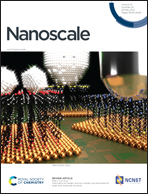Overcoming the asymmetry of the electron and hole doping for magnetic transitions in bilayer CrI3†
Abstract
Electrical control of magnetism has great potential for low-power spintronics applications and the newly discovered two-dimensional van der Waals magnetic materials are promising systems for this type of applications. In fact, it has been recently shown experimentally (Jiang et al., Nat. Nanotechnol., 2018, 13, 549–553) that upon electrostatic doping by electrons bilayer CrI3 undergoes an antiferromagnetic–ferromagnetic (AFM–FM) phase transition, even in the absence of magnetic field. Doping by holes, on the other hand, does not induce the same transition in the experiment, which points to an intrinsic asymmetry in the hole and electron doping that limits the control of the transition by doping. We here show, based on first-principles calculations, that the asymmetry originates in the relativistic nature of the valence-band-edge states of the pristine bilayer, which inhibits the magnetic transition upon hole doping. Based on this finding, we propose an approach to overcome the asymmetry and predict the existence of the AFM–FM transition for both hole and electron doping upon moderate uniaxial compression along the soft direction of the bilayer.



 Please wait while we load your content...
Please wait while we load your content...